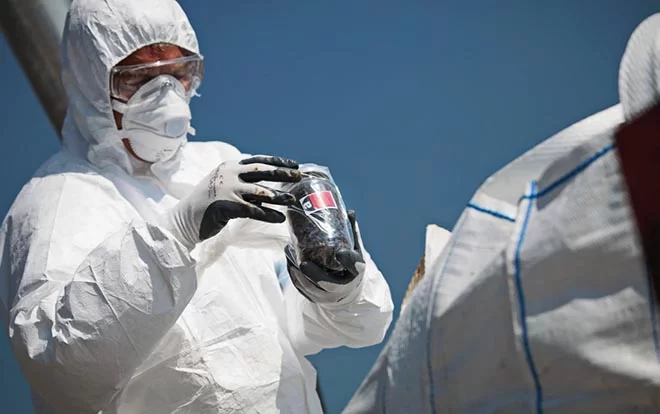What is asbestos?

Asbestos is a naturally occurring mineral, made up of soft, flexible fibres.
Once a popular material used in a wide range of applications, today it is banned in the UK. However, it can still be found in any building that was built or refurbished prior to 2000.
Whether you’re working on site or carrying out DIY, it’s important you’re aware of this material and the potential risks surrounding asbestos exposure.
How is asbestos made?
Asbestos is not man-made. It is comprised of a group of six types of naturally occurring minerals found in rocks and soil all around the world. These minerals mainly consist of silicon and oxygen, however they also contain other elements.
Asbestos is extracted from the earth by mining, large scale mining started in the 1870s in Quebec, Canada. Today, it is still mined in some countries, including Russia, Kazakhstan, China, and Brazil. Russia is the world’s largest producer, with an annual production of around 790,000 million metric tonnes in 2020.
Why was asbestos used?
If asbestos is dangerous, why was it used so widely?
Although its use can be traced back as far as the ancient Greeks and Romans, asbestos became popular at the end of the 1800s because of the industrial revolution and the resulting industry boom.
It was widely sought after and an incredibly popular building material thanks to its many beneficial qualities:
- affordable
- strong
- fire-resistant
- heat resistant
- water resistant
- resistant to chemicals
- resistant to electricity
- insulating
- sound absorbing
- widely available
What was asbestos used for?
These beneficial properties made asbestos ideal for use in a wide range of products, including insulation, car brakes, floor tiles, fire proofing boards, roofing sheets, and pipes.
Back when it was still widely used, asbestos was found in over 3000 products, including everything from cladding and partitions to fire doors, toilet seats, and even fake snow and toothpaste.
At the peak of asbestos use in the 1960s and 1970s, over 170,000 tonnes were being imported in the UK each year.
Asbestos is commonly found in:
- ceiling or floor cavities
- lagging
- sprayed coatings on ceilings, walls and beams
- insulating board
- floor tiles
- textiles and composites
- textured coatings
- cement products
- roofing felt
- rope seals and gaskets
How many common types of asbestos are there?
There are six types of asbestos:
- Crocidolite
- Amosite
- Anthophyllite
- Tremolite
- Actinolite
- Chrysotile
The three most used types of asbestos in the UK were:
- Crocidolite (blue asbestos)
- Amosite (brown asbestos)
- Chrysotile (white asbestos)
When was asbestos banned?
Asbestos was fully banned in the UK in 1999 when the manufacture and supply of all asbestos products became illegal.
Crocidolite (blue asbestos) and amosite (brown asbestos) were banned in the UK in 1985, but chrysotile was not included in this initial ban.
How dangerous is asbestos?
If materials containing asbestos are intact and undamaged, they pose only a very minimal risk. However, if they are damaged or disturbed, asbestos fibres can be released into the air. If these fibres are inhaled, they can cause several serious and potentially fatal conditions, including:
- Mesothelioma – a cancer affecting the lining of the lungs and the lining surrounding the lower digestive tract. This type of cancer is almost exclusively related to asbestos exposure.
- Asbestos-related lung cancer – lung cancer caused by exposure to asbestos fibres.
- Asbestosis – scarring of the lungs, usually occurring because of heavy exposure to asbestos over an extended period of time. Symptoms include shortness of breath.
- Pleural thickening – the thickening and swelling of the lining of the lungs. This usually occurs after heavy asbestos exposure and can result in the squeezing of the lung itself, causing shortness of breath and discomfort in the chest.
The symptoms of many asbestos-related conditions can take years to show, as a result, many people who were exposed at the peak of asbestos use are only receiving a diagnosis today.
According to the Health and Safety Executive, asbestos kills around 5000 people in the UK each year, with 20 traders dying each week as the result of past exposure. That’s double the number of deaths caused by road traffic accidents each year.
Asbestos removal
If you uncover asbestos, it’s vital that you contact professional, qualified asbestos removal experts.
At The Waste Group, we offer the collection, transfer, and disposal of asbestos according to current waste regulations. All of the asbestos we handle is safely disposed of in designated transfer stations or hazardous waste landfill sites, in line with the Landfill Directive and Environmental Permitting Regulations.
Get in touch to find out more about our safe, secure and expert asbestos removal services.


